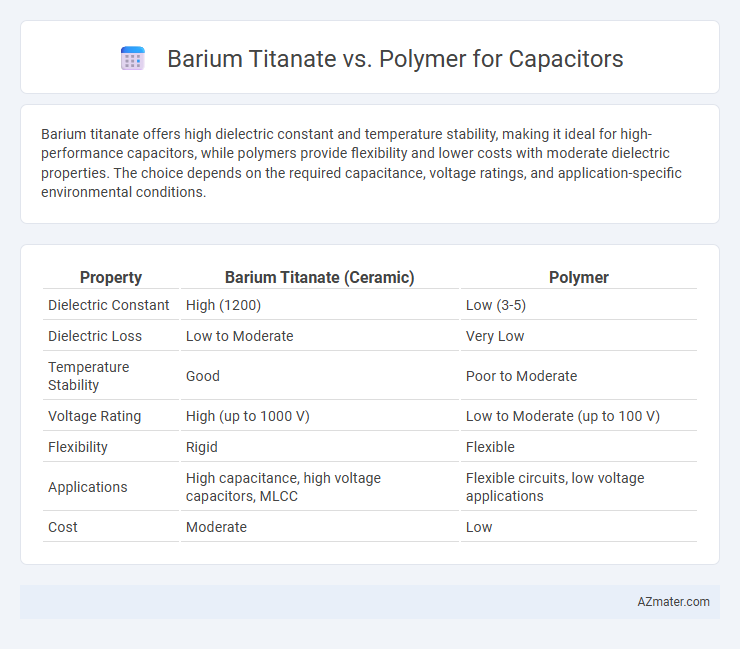Barium titanate offers high dielectric constant and temperature stability, making it ideal for high-performance capacitors, while polymers provide flexibility and lower costs with moderate dielectric properties. The choice depends on the required capacitance, voltage ratings, and application-specific environmental conditions.
Table of Comparison
| Property | Barium Titanate (Ceramic) | Polymer |
|---|---|---|
| Dielectric Constant | High (1200) | Low (3-5) |
| Dielectric Loss | Low to Moderate | Very Low |
| Temperature Stability | Good | Poor to Moderate |
| Voltage Rating | High (up to 1000 V) | Low to Moderate (up to 100 V) |
| Flexibility | Rigid | Flexible |
| Applications | High capacitance, high voltage capacitors, MLCC | Flexible circuits, low voltage applications |
| Cost | Moderate | Low |
Introduction: Barium Titanate vs Polymer Capacitors
Barium titanate capacitors offer high dielectric constants and excellent temperature stability, making them ideal for applications requiring robust performance and precision. Polymer capacitors provide lower ESR and higher ripple current ratings, which enhance efficiency and longevity in power electronics. Comparing Barium titanate to polymer capacitors highlights a trade-off between dielectric strength and electrical conductivity tailored to specific circuit demands.
Material Properties Comparison
Barium titanate exhibits a high dielectric constant and excellent ferroelectric properties, making it ideal for high-capacitance ceramic capacitors with stable temperature performance. Polymers, such as polypropylene and polyester, offer lower dielectric constants but provide superior flexibility, lightweight characteristics, and better mechanical durability. The choice between barium titanate and polymer dielectrics significantly impacts capacitor size, voltage rating, and frequency response in electronic applications.
Dielectric Constant Differences
Barium titanate exhibits a significantly higher dielectric constant, often exceeding 1000, compared to polymers whose dielectric constants typically range from 2 to 10. This high dielectric constant in barium titanate enables capacitors to achieve greater capacitance in smaller volumes, making it ideal for high-performance multilayer ceramic capacitors (MLCCs). Polymers, while having lower dielectric constants, offer advantages in flexibility and film-form formation for applications requiring lightweight and flexible capacitors.
Temperature Stability Analysis
Barium titanate capacitors exhibit superior temperature stability due to their high dielectric constant and low temperature coefficient, maintaining capacitance across a wide temperature range from -55degC to 125degC. Polymer capacitors, while offering better flexibility and lower ESR, tend to experience significant capacitance variation and reduced reliability at elevated temperatures above 85degC. The intrinsic ferroelectric properties of barium titanate make it more suitable for applications requiring consistent performance under thermal stress.
Electrical Performance and Efficiency
Barium titanate capacitors exhibit high permittivity and excellent dielectric strength, resulting in superior electrical performance and energy storage efficiency compared to polymer capacitors. Polymer capacitors offer lower dielectric losses and better frequency stability but generally have lower capacitance density and voltage handling capabilities. The choice between barium titanate and polymer capacitors depends on the application's demands for high capacitance, voltage tolerance, and efficiency under varying electrical conditions.
Size and Form Factor Considerations
Barium titanate capacitors offer higher dielectric constants, enabling smaller sizes for equivalent capacitance compared to polymer capacitors, making them ideal for compact electronic designs. Polymer capacitors, while generally larger due to lower permittivity, provide more flexible form factors and better mechanical stability in varied operating conditions. These size and form factor differences influence component selection based on device miniaturization requirements and durability considerations.
Reliability and Longevity
Barium titanate capacitors exhibit higher dielectric constants and stability under high-temperature environments, resulting in superior reliability and longer operational life compared to polymer capacitors. Polymer capacitors, while offering excellent ESR characteristics and flexibility, generally have shorter lifespan due to susceptibility to thermal and mechanical stress. Studies indicate barium titanate-based capacitors maintain capacitance and insulation resistance more effectively over extended cycles, making them preferred for demanding industrial and automotive applications.
Cost and Manufacturing Processes
Barium titanate capacitors offer high dielectric constant and excellent temperature stability but involve complex, high-temperature ceramic sintering processes that increase manufacturing costs compared to polymer capacitors. Polymer capacitors feature lower production expenses due to simpler extrusion and foil lamination techniques, benefiting from scalability and reduced material costs. Cost efficiency in polymer capacitors makes them preferable for large-volume, flexible applications, while barium titanate remains ideal where superior electrical properties justify the higher manufacturing investment.
Ideal Application Scenarios
Barium titanate capacitors excel in high-permittivity applications requiring stable dielectric properties and high energy density, making them ideal for multilayer ceramic capacitors (MLCCs) used in power electronics and precision filtering. Polymer capacitors are preferred for scenarios demanding high capacitance with low equivalent series resistance (ESR) and enhanced thermal stability, such as audio circuits, power supply decoupling, and automotive electronics. Choosing between barium titanate and polymer capacitors depends on specific requirements for dielectric constant, voltage rating, frequency response, and operational temperature range.
Future Trends in Capacitor Technologies
Barium titanate remains a critical ceramic material in capacitors due to its high dielectric constant and temperature stability, making it essential for miniaturized, high-capacity components in advanced electronics. Polymer capacitors, especially those employing conductive polymers and nanocomposites, offer flexibility and improved ESR performance, driving growth in wearable and flexible electronics markets. Future trends emphasize hybrid capacitor technologies that combine barium titanate's dielectric strength with polymer flexibility to enhance energy density, thermal stability, and mechanical robustness for next-generation energy storage solutions.

Infographic: Barium titanate vs Polymer for Capacitor
 azmater.com
azmater.com